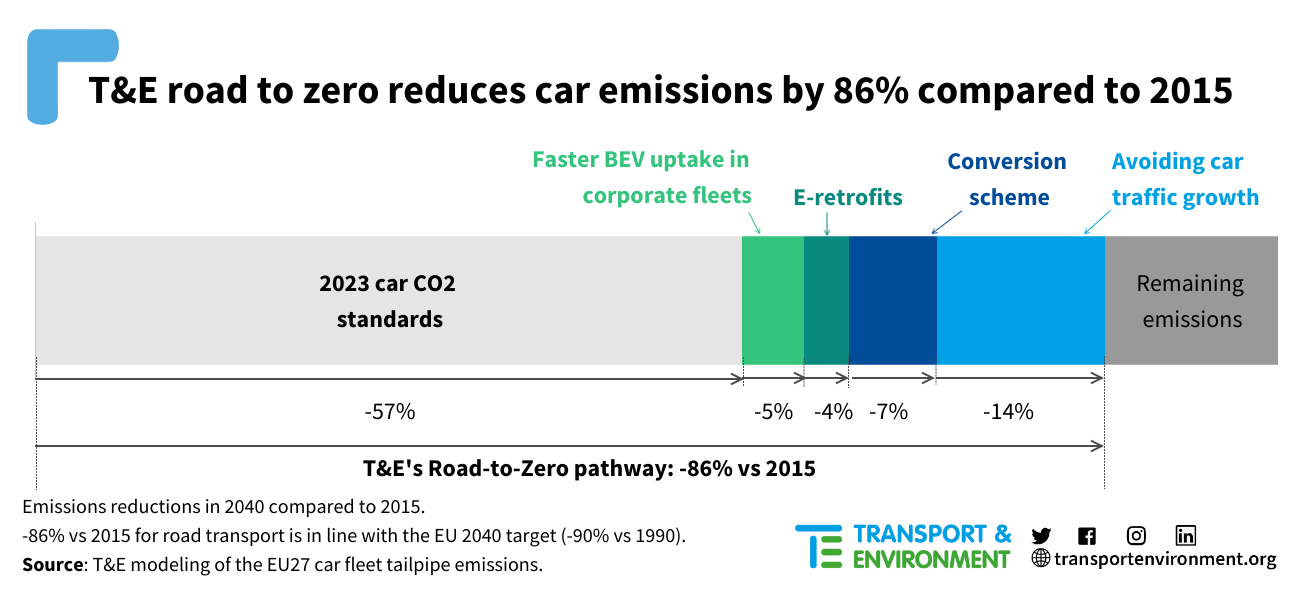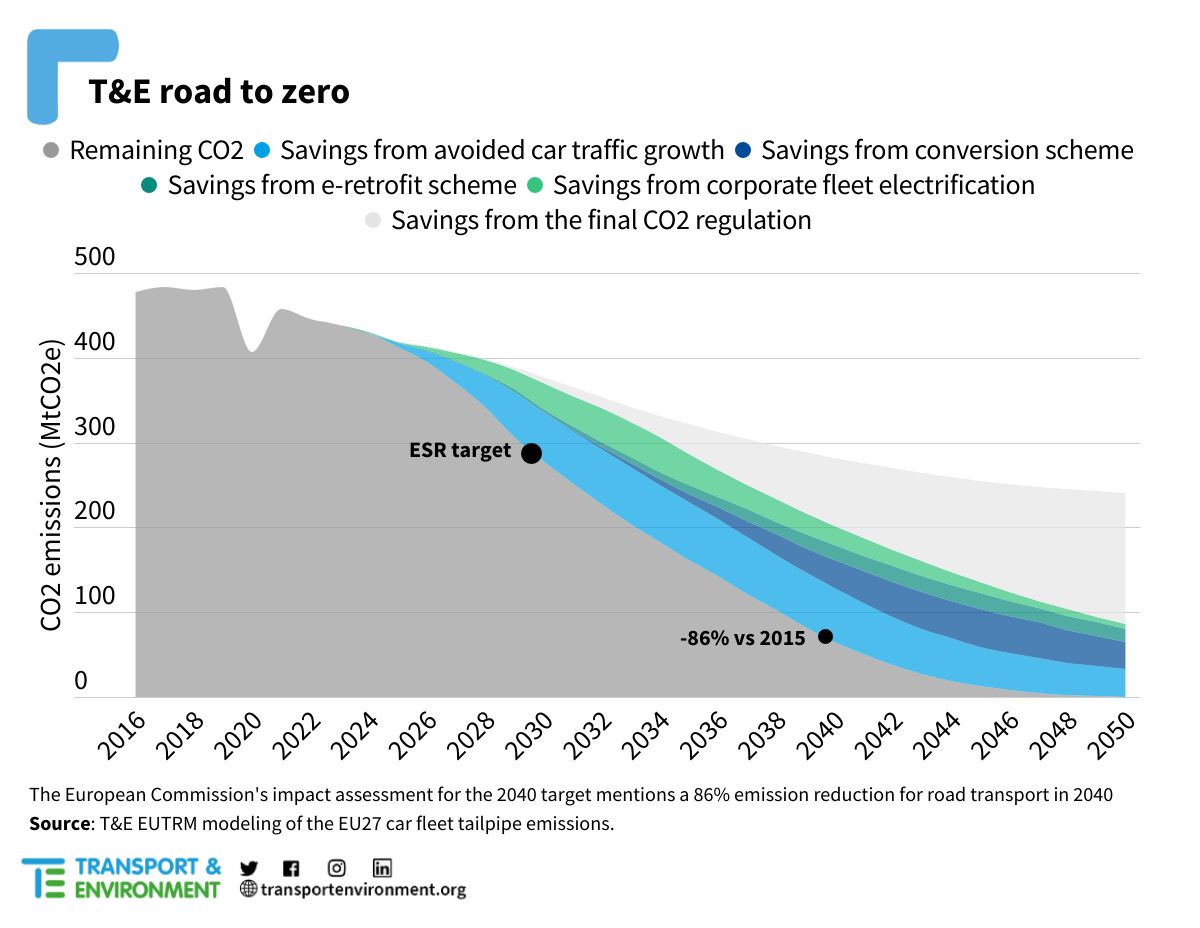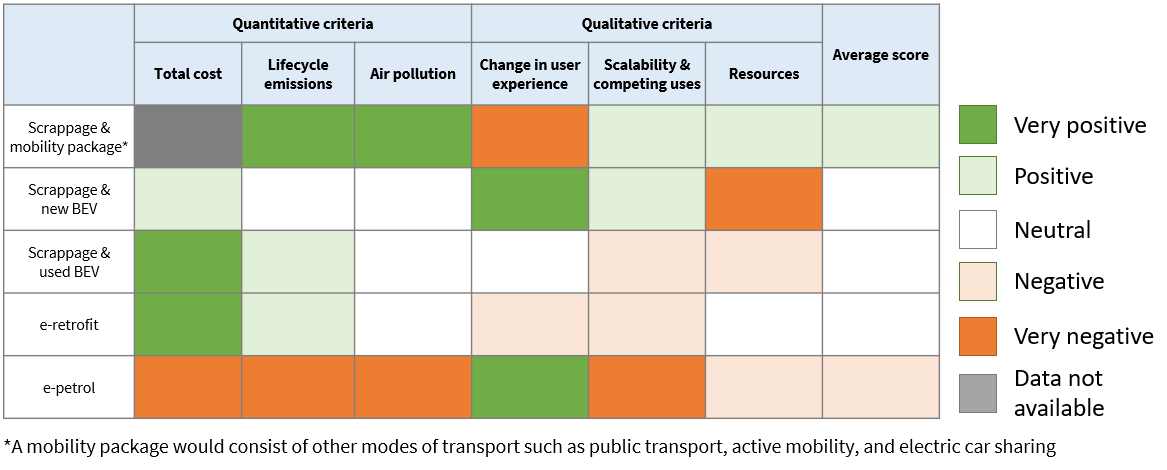The European Commission has just announced a -90% CO₂ reduction target across the European economy by 2040. To achieve this we need to move beyond focusing only on new sales and clean up the entire car fleet. T&E’s Road-to-Zero roadmap would secure the EU’s climate targets while providing clean and affordable solutions to help all drivers make the transition away from polluting fossil cars.
- The current 2023 car CO₂ regulation, including the 2035 internal combustion engine (ICE) phase-out, is the single most important emission reduction measure, as it will reduce emissions by 57% in 2040 compared to 2015.
- Additional measures are needed to phase out the remaining 73 million ICEs on our roads in 2050. The most effective and affordable options are scrapping old ICEs (and replacing them with battery electric vehicles, BEVs), followed by e-retrofits of ICEs.
- E-fuels are more expensive and inefficient than other options, and as such are not needed to reduce the CO₂ emissions of the existing fleet.
- Accelerating the BEV uptake in corporate fleets and avoiding the growth in car traffic by limiting new road construction or encouraging modal shifts are additional effective levers to reduce emissions in line with EU climate ambition.
T&E road to zero reduces car emissions by 86% in 2040

This report presents T&E’s car decarbonisation roadmap. It first shows that the 2035 ICE phase-out is an essential measure to decarbonise cars. However, the legislated car CO₂ standards need to be complemented to eliminate the emissions of the legacy ICE fleet and meet the EU’s climate ambition to reduce road transport emissions by 86%(compared to 2015) while ensuring socially just transition.
Beyond the legislated car CO₂ standards affecting all new car sales, we analyse the impacts of accelerating the electrification of corporate cars and we assess options for decarbonising the ICEs that will be on Europe’s roads in 2050, considering conversion schemes coupled with alternative mobility options and e-retrofits.
T&E’s road-to-zero pathway combines clean solution to meet EU’s climate targets

Accelerating the EV uptake in corporate fleets
A faster uptake of BEVs is needed to meet EU’s climate targets and all sales of new corporate fleet vehicles need to be BEV by 2030. Given the higher mileage of cars in corporate fleets and the high fleet turnover rate, decarbonising corporate fleet sales is very effective to bring additional CO₂ savings and second hand BEVs to the market. With these targets, annual fleet emissions could be reduced by an additional 5% in 2040.
Phasing out all remaining ICEs by 2050
The comparison of the different alternatives shows that conversion schemes and e-retrofits – the conversion of a fossil car to electric car – should be prioritised as they are the most appropriate and effective solutions to phase out the remaining ICEs by 2050. On the other hand, the use of e-fuels in cars does not make environmental, economic and industrial sense.
A conversion scheme, where the driver gives up car ownership and opts for a mobility package (public transport and shared mobility), would be a good option in areas where the infrastructure for public transport and active mobility is sufficiently developed. The conversion scheme could also include subsidies for the purchase of a new BEV, or leasing it as part of a social leasing scheme, or for the purchase of a used BEV. E-retrofitting ICEs will provide an additional solution for low-income drivers and people who really need a car. Both conversion and e-retrofits schemes will enable the removal of all old ICEs from the fleet by 2050 and reduce emissions by an additional 11% in 2040. E-petrol was found to have the highest cost to the owner, higher lifecycle CO₂ emissions and would not reduce urban air pollution. Crucially, e-fuels and the hydrogen needed to produce them will be required in hard to abate sectors (e.g. aviation and shipping), so there is no guarantee that e-petrol would be available for cars.
E-petrol makes no environmental, economic and industrial sense

Remaining emissions would be reduced by avoiding an increase in car traffic
Between 2000 and 2018, passenger activity in EU cars has increased by about 17%, and the European Commission expects it to grow by 20% by 2050. The T&E roadmap aims to avoid this growth in car use relying on three main levers: stopping new road construction, shifting to public transport and active mobility in cities, shifting to rail for longer distances, and we also modelled the impact of fuel price increases on demand. To further reduce emissions, these measures would be combined with additional levers to increase car occupancy (e.g. carpooling) and reduce fuel consumption (shifting sales away from SUVs). These measures would reduce emissions by an additional 14% in 2040.
Key recommendations
- The EU needs to maintain the 2035 ICE phase-out.
- The European Commission is developing a new initiative for the greening of company fleets. The EU needs to set a target of 100% BEV sales in 2030 for corporate cars with an intermediate target of 50% in 2027 in order to achieve a faster ramp-up of BEV sales.
- Policy solutions need to be specifically targeted at the existing car fleet, in particular e-retrofitting of old ICE cars and conversion schemes for low-income households including support for mobility (e.g. public transport, car sharing) or a new or used BEV, while avoiding inefficient and expensive solutions such as e-fuels.
- The European Commission should adjust its 2040 strategy and account for conversion schemes and e-retrofits instead of e-fuels for the legacy fleet. To accelerate the phase out of the oldest ICEs, T&E suggests implementing sales or circulation restrictions on used ICEs after a certain age. Then, the European Commission should propose as soon as possible a new EU type-approval regulation for e-retrofitted vehicles.
- Actions are needed to prevent the growth of car use by limiting new road building, shifting car use to other modes and increasing car occupancy.


